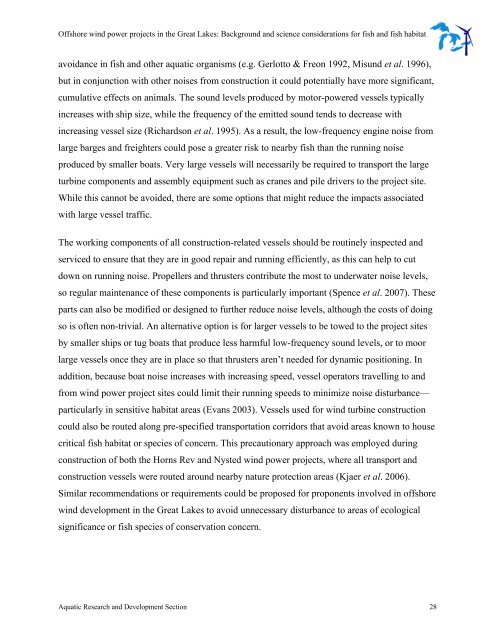Offshore Wind Power Projects in the Great Lakes - Ministry of ...
Offshore Wind Power Projects in the Great Lakes - Ministry of ...
Offshore Wind Power Projects in the Great Lakes - Ministry of ...
Create successful ePaper yourself
Turn your PDF publications into a flip-book with our unique Google optimized e-Paper software.
<strong>Offshore</strong> w<strong>in</strong>d power projects <strong>in</strong> <strong>the</strong> <strong>Great</strong> <strong>Lakes</strong>: Background and science considerations for fish and fish habitat<br />
avoidance <strong>in</strong> fish and o<strong>the</strong>r aquatic organisms (e.g. Gerlotto & Freon 1992, Misund et al. 1996),<br />
but <strong>in</strong> conjunction with o<strong>the</strong>r noises from construction it could potentially have more significant,<br />
cumulative effects on animals. The sound levels produced by motor-powered vessels typically<br />
<strong>in</strong>creases with ship size, while <strong>the</strong> frequency <strong>of</strong> <strong>the</strong> emitted sound tends to decrease with<br />
<strong>in</strong>creas<strong>in</strong>g vessel size (Richardson et al. 1995). As a result, <strong>the</strong> low-frequency eng<strong>in</strong>e noise from<br />
large barges and freighters could pose a greater risk to nearby fish than <strong>the</strong> runn<strong>in</strong>g noise<br />
produced by smaller boats. Very large vessels will necessarily be required to transport <strong>the</strong> large<br />
turb<strong>in</strong>e components and assembly equipment such as cranes and pile drivers to <strong>the</strong> project site.<br />
While this cannot be avoided, <strong>the</strong>re are some options that might reduce <strong>the</strong> impacts associated<br />
with large vessel traffic.<br />
The work<strong>in</strong>g components <strong>of</strong> all construction-related vessels should be rout<strong>in</strong>ely <strong>in</strong>spected and<br />
serviced to ensure that <strong>the</strong>y are <strong>in</strong> good repair and runn<strong>in</strong>g efficiently, as this can help to cut<br />
down on runn<strong>in</strong>g noise. Propellers and thrusters contribute <strong>the</strong> most to underwater noise levels,<br />
so regular ma<strong>in</strong>tenance <strong>of</strong> <strong>the</strong>se components is particularly important (Spence et al. 2007). These<br />
parts can also be modified or designed to fur<strong>the</strong>r reduce noise levels, although <strong>the</strong> costs <strong>of</strong> do<strong>in</strong>g<br />
so is <strong>of</strong>ten non-trivial. An alternative option is for larger vessels to be towed to <strong>the</strong> project sites<br />
by smaller ships or tug boats that produce less harmful low-frequency sound levels, or to moor<br />
large vessels once <strong>the</strong>y are <strong>in</strong> place so that thrusters aren’t needed for dynamic position<strong>in</strong>g. In<br />
addition, because boat noise <strong>in</strong>creases with <strong>in</strong>creas<strong>in</strong>g speed, vessel operators travell<strong>in</strong>g to and<br />
from w<strong>in</strong>d power project sites could limit <strong>the</strong>ir runn<strong>in</strong>g speeds to m<strong>in</strong>imize noise disturbance—<br />
particularly <strong>in</strong> sensitive habitat areas (Evans 2003). Vessels used for w<strong>in</strong>d turb<strong>in</strong>e construction<br />
could also be routed along pre-specified transportation corridors that avoid areas known to house<br />
critical fish habitat or species <strong>of</strong> concern. This precautionary approach was employed dur<strong>in</strong>g<br />
construction <strong>of</strong> both <strong>the</strong> Horns Rev and Nysted w<strong>in</strong>d power projects, where all transport and<br />
construction vessels were routed around nearby nature protection areas (Kjaer et al. 2006).<br />
Similar recommendations or requirements could be proposed for proponents <strong>in</strong>volved <strong>in</strong> <strong>of</strong>fshore<br />
w<strong>in</strong>d development <strong>in</strong> <strong>the</strong> <strong>Great</strong> <strong>Lakes</strong> to avoid unnecessary disturbance to areas <strong>of</strong> ecological<br />
significance or fish species <strong>of</strong> conservation concern.<br />
Aquatic Research and Development Section 28
















